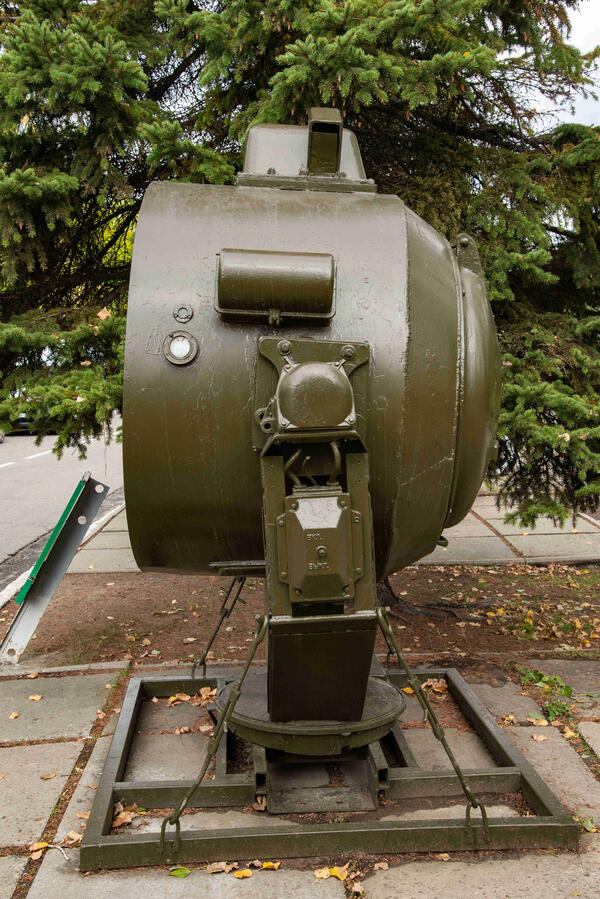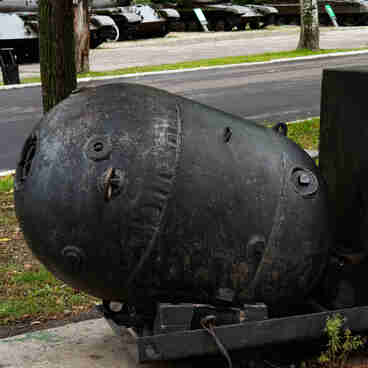The Z-15-4 anti-aircraft searchlight was designed to support anti-aircraft artillery fire and combat operations of air defense fighter aviation in the dark. This was the most common removable searchlight of the closed type.
The station was equipped with an instant-start electric arc lamp with two carbon electrodes and a mirrored parabolic reflector with a diameter of 1.5 m. The high-intensity electric arc was the light source. It delivered up to 650 million candelas (W) with an effective beam visibility of up to 10 km.
The electrodes lasted 75 minutes, after which they were replaced. Depending on the modification of the station, the beam could illuminate enemy aircraft in the night sky at an altitude of 9 to 12 kilometers.
The power to the searchlight could be supplied both from a mobile power source — a 20 kW generator — and from stationary sources. The station was mounted on the chassis of a ZIS-12 truck. It was produced from 1938 to 1942 at the Moscow Searchlight Plant. A total of 15.5 thousand units were manufactured. The production was terminated as powerful target acquisition and tracking radar stations were developed and sent to the troops.
The Z-15-4 searchlights were delivered to separate anti-aircraft searchlight battalions, which consisted of three companies (with three platoons). A platoon used four searchlight stations. In action, the searchlights were employed to find enemy aircraft in the sky with a beam of light and illuminate and follow the target until it was destroyed by fire.
The first task was performed by a searchlight with the only purpose of scanning the sky. It was equipped with a synchronous communication system and was part of the “Prozhzvuk” system (“Prozhzvuk-2”, “Prozhzvuk-4”). Prozhzvuk is an acronym culled from the Russian words for searchlight (“prozhektor”) and sound (“zvuk”). The tracker-searchlight carried out the second task. It was not fitted with communication devices and was not part of the “Prozhzvuk” system.
Anti-aircraft searchlight stations were also used to illuminate ground targets. Thus, for anti-tank defense purposes, anti-aircraft searchlights were employed near Moscow and Tula in the autumn of 1941, and near Stalingrad in the summer of 1942.
The station was equipped with an instant-start electric arc lamp with two carbon electrodes and a mirrored parabolic reflector with a diameter of 1.5 m. The high-intensity electric arc was the light source. It delivered up to 650 million candelas (W) with an effective beam visibility of up to 10 km.
The electrodes lasted 75 minutes, after which they were replaced. Depending on the modification of the station, the beam could illuminate enemy aircraft in the night sky at an altitude of 9 to 12 kilometers.
The power to the searchlight could be supplied both from a mobile power source — a 20 kW generator — and from stationary sources. The station was mounted on the chassis of a ZIS-12 truck. It was produced from 1938 to 1942 at the Moscow Searchlight Plant. A total of 15.5 thousand units were manufactured. The production was terminated as powerful target acquisition and tracking radar stations were developed and sent to the troops.
The Z-15-4 searchlights were delivered to separate anti-aircraft searchlight battalions, which consisted of three companies (with three platoons). A platoon used four searchlight stations. In action, the searchlights were employed to find enemy aircraft in the sky with a beam of light and illuminate and follow the target until it was destroyed by fire.
The first task was performed by a searchlight with the only purpose of scanning the sky. It was equipped with a synchronous communication system and was part of the “Prozhzvuk” system (“Prozhzvuk-2”, “Prozhzvuk-4”). Prozhzvuk is an acronym culled from the Russian words for searchlight (“prozhektor”) and sound (“zvuk”). The tracker-searchlight carried out the second task. It was not fitted with communication devices and was not part of the “Prozhzvuk” system.
Anti-aircraft searchlight stations were also used to illuminate ground targets. Thus, for anti-tank defense purposes, anti-aircraft searchlights were employed near Moscow and Tula in the autumn of 1941, and near Stalingrad in the summer of 1942.




